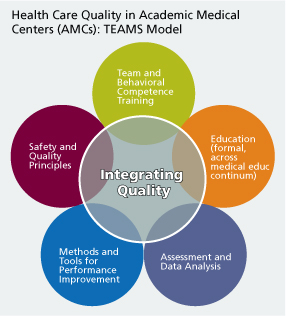
What is the purpose of the health it and patient safety report?
Specifically, it focuses on reducing the risks of health IT-assisted care, and it identifies areas of concern to help put the nation in a better position to fully benefit from health IT. Institute of Medicine. (2011). Health IT and Patient Safety: Building Safer Systems for Better Care.
Is there a framework for patient safety and Health Information Technology?
This book provides recommendations for developing a framework for patient safety and health IT (information technology). Specifically, it focuses on reducing the risks of health IT-assisted care, and it identifies areas of concern to help put the nation in a better position to fully benefit from health IT. Institute of Medicine. (2011).
What is the purpose of the book @Health IT and patient safety?
Health IT and Patient Safetymakes recommendations for developing a framework for patient safety and health IT. This book focuses on finding ways to mitigate the risks of health IT-assisted care and identifies areas of concern so that the nation is in a better position to realize the potential benefits of health IT.

How does health IT help?
Designed and properly applied, health IT can be a positive transformative force for delivering safe health care, particularly with computerized prescribing and medication safety. However, if it is designed and applied inappropriately, health IT can add an additional layer of complexity to the already complex delivery of health care. Poorly designed IT can introduce risks that may lead to unsafe conditions, serious injury, or even death. Poor human-computer interactions could result in wrong dosing decisions and wrong diagnoses. Safe implementation of health IT is a complex, dynamic process that requires a shared responsibility between vendors and health care organizations. Health IT and Patient Safetymakes recommendations for developing a framework for patient safety and health IT. This book focuses on finding ways to mitigate the risks of health IT-assisted care and identifies areas of concern so that the nation is in a better position to realize the potential benefits of health IT.
What is information technology?
Information technology (IT) has been identified as a way to enhance the safety and effectiveness of care. In an effort to catalyze its implementation, the U.S. government has invested billions of dollars toward the development and meaningful use of effective health IT.
EVALUATING THE CURRENT STATE OF PATIENT SAFETY AND HEALTH IT
The expectations for safer care may be higher in a health IT–enabled environment as compared to a paper-based environment because the opportunity to improve patient care is much greater.
EXAMINING THE CURRENT STATE OF THE ART IN SYSTEM SAFETY
Software-related safety issues are often ascribed to software coding errors or human errors in using the software. It is rarely that simple. Many problems with health IT relate to usability, implementation, and how software fits with clinical workflow.
OPPORTUNITIES TO BUILD SAFER SYSTEMS FOR HEALTH IT
Merely installing health IT in health care organizations will not result in improved care. Together, the design, implementation, and use of health IT affect its safe performance. Safer implementation and use of health IT is a complex, dynamic process that requires a shared responsibility between vendors and health care organizations.
A SHARED RESPONSIBILITY FOR IMPROVING HEALTH IT SAFETY
Health IT safety is contingent on how the technology is designed, implemented, used, and fits into clinical workflow, requiring the cooperation of both vendors and users. In the absence of a single accountable party, policy makers need to act on behalf of the public good to promote and monitor health IT safety.
FUTURE RESEARCH FOR CARE TRANSFORMATION
The committee identified a number of research gaps during its information gathering. Research is needed to continue to build the evidence to determine how to develop and adopt safer health IT most effectively. A greater body of conclusive research is needed to fully meet the potential of health IT for ensuring patient safety.
Footnotes
The IOM identified six aims of quality improvement, stating that health care should be safe, effective, patient-centered, timely, efficient, and equitable.
What is health IT?
Health IT, when well designed and implemented, is a tool that can help health information flow in ways that allow for improvements in patient health and safety. Whatever the drawbacks to health IT systems, the evidence suggests that health IT has raised the floor on safety.
When was the IOM right?
It is good to know that the evidence, so far, suggests that the IOM was right back in 2000. We should be going down this path. The widespread adoption of health IT has been a clear benefit to patient safety. We need to continue to work on making health IT even better in a redesigned health system with patient safety and quality its first priority.
Is health IT a silver bullet?
Health IT is not and never will be a “silver bullet” that reduces unsafe conditions, errors, and adverse events. To improve safety and quality, health IT is an important part of delivery system reform and redesigned systems of care. Health IT, when well designed and implemented, is a tool that can help health information flow in ways ...
Does advanced health IT improve surgical safety?
One recent study also showed health IT has improved surgical safety.
Does health IT improve patient safety?
Since then, whether health IT actually improves patient safety has remained an open question. The nation has seen widespread adoption of health IT as a result of the Medicare and Medicaid EHR Incentive Programs. With that increase in adoption, there should be more and better evidence on the actual impact of health IT on safety.
How does health IT help?from pubmed.ncbi.nlm.nih.gov
Designed and properly applied, health IT can be a positive transformative force for delivering safe health care, particularly with computerized prescribing and medication safety. However, if it is designed and applied inappropriately, health IT can add an additional layer of complexity to the already complex delivery of health care. Poorly designed IT can introduce risks that may lead to unsafe conditions, serious injury, or even death. Poor human-computer interactions could result in wrong dosing decisions and wrong diagnoses. Safe implementation of health IT is a complex, dynamic process that requires a shared responsibility between vendors and health care organizations. Health IT and Patient Safetymakes recommendations for developing a framework for patient safety and health IT. This book focuses on finding ways to mitigate the risks of health IT-assisted care and identifies areas of concern so that the nation is in a better position to realize the potential benefits of health IT.
What is information technology?from pubmed.ncbi.nlm.nih.gov
Information technology (IT) has been identified as a way to enhance the safety and effectiveness of care. In an effort to catalyze its implementation, the U.S. government has invested billions of dollars toward the development and meaningful use of effective health IT.
How long does it take for HHS to publish a surveillance plan?
The recommendations include the following: 1. The Secretary of HHS should publish an action and surveillance plan within 12 months to outline how HHS will work with the private sector to assess the impact of HIT on patient safety and minimize any associated risks. 2.
Should HHS collaborate with other research groups?
HHS should collaborate with other research groups and support cross-disciplin ary research in using HIT as part of a learning healthcare system. Study: U.S. Patients Need More Control Over EHRs for Healthcare to Gain Their Benefits. Half of Physicians Say EHRs are Safer Than Paper, But Patients Still Wary.
When was the report "Improving Diagnosis in Health Care" published?
Improving Diagnosis in Health Care , published in 2015, this report investigates diagnostic errors, something that most patients will experience at least once in their lifetime. This report is a continuation of the landmark Institute of Medicine reports To Err is Human: Building a Safer Health System (2000) and Crossing the Quality Chasm: A New Health System for the 21st Century (2001).
What is the 2011 report on child and adolescent health and health care quality?
Child and Adolescent Health and Health Care Quality: Measuring What Matters This 2011 report an assessment of both the state and the science of child and adolescent health and health care quality measurement, as well as the capacity of existing data systems to track and evaluate programs and services intended to serve the health care needs of these populations.
What is the National Academy of Medicine?
AHRQ has long collaborated with the National Academy of Medicine (formerly Institute of Medicine) to develop comprehensive reports on topics that are critical to making the American health care system safer and higher quality. These reports represent the consensus recommendations from experts in ...
What is the 2009 report on ethnicity and language?
Race, Ethnicity, and Language Data: Standardization for Health Care Quality Improvement is a 2009 report that recommends collection of more granular ethnicity and language need according to national standards in addition to OMB race and Hispanic ethnicity categories.
What are clinical practice guidelines?
Clinical practice guidelines are statements that include recommendations intended to optimize patient care. They are informed by a systematic review of evidence and an assessment of the benefits and harms of alternative care options.
What is the future of rural health?
Quality Through Collaboration: The Future of Rural Health is a 2004 report that examines the quality of health care in rural America and offers a strategy for future work.
